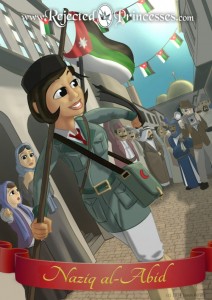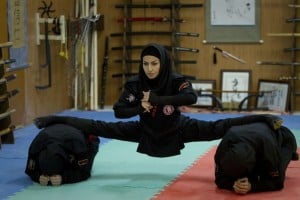If you’re our regular reader, you know that mainstream media sorely lacks female characters who have a range of emotions, abilities and ambitions – in other words: real women.
Children’s animated films are of no exception. It was only in 2009 that Disney introduced its first Disney princess of colour, black princess Tiana from The Princess and the Frog. More recently, Princess Elsa of Frozen (2013) was lauded for being a “complex and contentious heroine” by the Feminist Wire. But most characters and children’s media role models remain lacking in agency or any strong characteristics.
Enter Rejected Princesses, or “women too awesome, awful or offbeat for kids’ movies”, a project by “straight white dude from Kentucky” Jason Porath. He’s also working on a book slated for 2016, that will feature more women who are not included in the blog.
With a list of more than 750 badass women candidates waiting, I asked him how he picked the lineup for each week.
“Generally speaking, I try to provide a wide range of representation – not too many martial heroines in a row, try to hit up different areas of the globe each week, etc. Generally speaking, I try to present stories where the Rejected Princess has agency, character, and struggle. The people who most easily fit that bill, historically, are warrior women. Many historical female artists lack struggle. Many martyrs lack agency. It’s a difficult balancing act.”
A couple of Muslim women characters featured are (in order of historical appearance) Mamluk sultan(ah) Shajar al-Durr from the early 13th century and Syrian general Naziq al-Abid (1898-1959). Noor Inayat Khan has her own entry as well, and she is repeatedly described as “pacifist”, having been “raised Muslim and Sufi” – similar to what MMW’s Tasnim pointed out in the framing of Noor’s biography in the documentary-drama Enemy of the Reich (2014).
This blog raises the questions of how can an artist actively work against stereotypes of (Muslim) women, and what can be considered a measure of success?

For the enormous task that Jason has set out to do – actively highlighting women with agency – he’s done an immense amount of historical research. It shows in the way these stories are written: for a lay audience, cramming loads of historical information and trivia in a simple and engaging way.
First, Shajar al-Durr is one badass sultanah. Why had I never heard of her before? Shajar was a Mamluk servant who became a “full-on Sultan, with the support of the military. She printed her own coins and led her own prayers – both of which were big deals to solidify her legitimacy. She was the real deal.” The fact that she led prayers is woven casually into the description of her other political achievements, a great example of how to normalise her awesomeness.
Second, the story of Naziq al-Abid lists an impressive array of achievements: she “spoke five languages, started the Syrian Red Crescent (and half a dozen other organisations), first female general in Syrian history, and possibly held the world record for greatest number of times sent into exile.” It contains a gem of an explanation about why Naziq was depicted as taking off her veil:
“She’s seen here ripping off a veil, since going veil-less was a big part of her life. Not that there’s anything wrong with choosing to wear a veil — she just didn’t have that choice for the most part, although she wanted it badly.”
This paragraph proves that it doesn’t take many words to give the complex phenomenon of hijab/niqab/burqa some nuance instead of framing it as being opposite to freedom or agency.
But is highlighting lesser known but just-as-if-not-more-amazing women in history enough to change mainstream ideas about what kinds of characters end up in leading roles? As a former effects animator at Dreamworks, Jason doesn’t think change will come from the top-down.
“Just start making those stories, and make them good. I really don’t think there’s any other way to it. Animation studios are big institutions with a lot of responsibilities – they usually don’t have the agility or the luxury to experiment. With Rejected Princesses, I’m only beholden to myself, so I can operate more like a startup and try new things. I think that’s the only way it’s really going to happen, is if grassroots efforts start showing equally viable alternatives.”
Such an endeavour is sure to invite a lot of criticism. But Jason is open to feedback: on his site he gives out a tongue-in-cheek “Nog Prize” for anyone who writes in with a good correction on historical facts or details in his artwork. (Plus, the prize is named after the “female gaze” of Greek goddess of wisdom, Athena.)
He describes himself as an “unlikely candidate to make an illustration blog about feminist, historical, multicultural butt-kicking ladies”, as he checks his white male privilege. In an interview with Jenna Busch of Legion of Leia, he talks about how difficult it is to get details right or make all readers happy.
“I’m not a historian. I enjoy this stuff and I work hard to get it right, but there are a lot of details to wrangle. Moreover, people have very deeply held opinions and emotions around many of the women represented (…) Getting things right is very important to me. It’s also extremely difficult, it turns out.”
This self-reflexivity in artistic creation is refreshing, and perhaps why I keep checking the blog every Wednesday. As much as we would like to think we are neutral, unbiased or objective, the fact is that each of us comes to an issue from a standpoint. Perhaps success is a process; it’s when we acknowledge how our experiences affect our worldview and when we remain humble in working to change dominant narratives.
“A lot of people write me asking for grand, sweeping statements on, say, the nature of feminism, or people of colour in the media, or whatnot. I feel almost completely unqualified to make any such statements. I usually just answer with, ‘Do you really want another random white dude on the Internet mouthing off as to what he thinks about the representation of women?'”
“In the end, that sort of pre-emptive privilege-check helps keep me focused on a more humble track. I just think these [women] are neat and want to celebrate them.”












